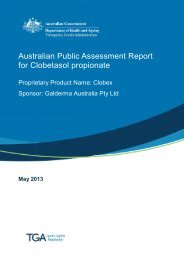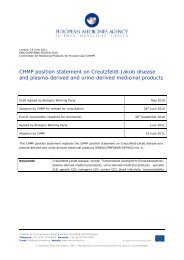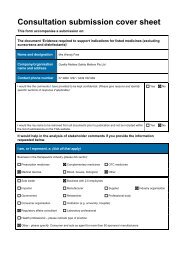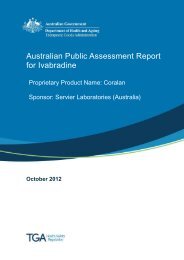Australian public assessment for Ibuprofen - Therapeutic Goods ...
Australian public assessment for Ibuprofen - Therapeutic Goods ...
Australian public assessment for Ibuprofen - Therapeutic Goods ...
Create successful ePaper yourself
Turn your PDF publications into a flip-book with our unique Google optimized e-Paper software.
AusPAR Caldolor <strong>Ibuprofen</strong> Phebra Pty Ltd PM-2010-02393-3-1<br />
Final 2 January 2013<br />
<strong>Therapeutic</strong> <strong>Goods</strong> Administration<br />
Consumption of rescue medication (in this case morphine) and area under the painintensity<br />
versus time curve are standard efficacy outcomes in pain studies and consistent<br />
with the relevant TGA-adopted guideline 16. The VAS is a standard method of assessing<br />
pain. The length of time over which the primary outcomes were assessed is consistent<br />
with an acute pain indication.<br />
Sample size<br />
CPI-CL-008A was conducted first, to determine the most appropriate dose of Caldolor <strong>for</strong><br />
the treatment of post-operative pain. Initially, 225 patients were to be randomised to<br />
placebo, 400 mg Caldolor q6h, or 800 mg Caldolor q6 h. After approximately 75% of these<br />
(168 patients) had completed the study, an analysis of variance was conducted without<br />
breaking the blind and without dividing the in<strong>for</strong>mation by groups. An independent<br />
statistician responsible <strong>for</strong> running this analysis recommended that the sample size be<br />
increased to provide a total EEP of not less than 360. A total of 406 participants were<br />
actually randomised, leading to an EEP of 342.<br />
Based on the results of CPI-CL-008A, CPI-CL-008B used only the Caldolor 800 mg q6h<br />
regimen and was planned to include 145 patients per group in the EEP (290 total) with the<br />
expectation of providing 90% power to detect a 20% reduction in morphine use in the<br />
Caldolor group compared to placebo, at a significance level of 0.05.<br />
Based on the results of CPI-CL-008A, CPI-CL-008C had a planned sample size of 67 per<br />
group, which was expected to provide 90% power to detect a 20% reduction in pain-AUC<br />
with movement in the Caldolor group compared to placebo, at a significance level of 0.05.<br />
Randomisation and blinding methods<br />
Randomisation in the pivotal studies was by means of sealed envelopes containing<br />
treatment assignments that were prepared centrally and provided to each study site<br />
pharmacy. Randomisation to the treatment groups in each study was on a 1:1 basis.<br />
Randomisation was stratified by weight (≤75 kg and >75 kg) and age (≤45 years and >45<br />
to 70 years in CPI-CL-008A and B; ≤45 years and >45 to 80 years in 008C).<br />
All three studies were double-blind. As in the fever studies, the pharmacists who prepared<br />
the study medication were aware of the treatment allocation but were instructed to<br />
puncture the additive port of the placebo normal saline bags to maintain the double blind<br />
<strong>for</strong> patients, investigators and nursing staff.<br />
Analysis populations<br />
In CPI-CL-008A and B, analyses were per<strong>for</strong>med in the following populations:<br />
• ITT population: All randomised patients who received at least a partial dose of study<br />
medication.<br />
• EEP: Patients from the ITT population who received the first 4 doses of study<br />
medication within ± 60 minutes of the scheduled time.<br />
• Abdominal hysterectomy (AH) population (CPI-CL-008A): Women from the EEP who<br />
underwent abdominal hysterectomy.<br />
In CPI-CL-008C, analyses were per<strong>for</strong>med in the following populations:<br />
• All-treated (AT) population: All randomised patients who received at least one dose of<br />
study medication.<br />
• ITT population: Patients from the AT population who received at least one postsurgical<br />
dose of study medication or at least one dose of morphine <strong>for</strong> break-through<br />
pain.<br />
Page 46 of 118
















